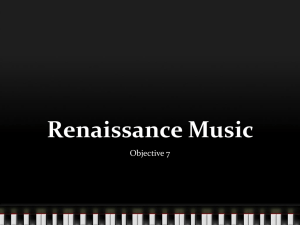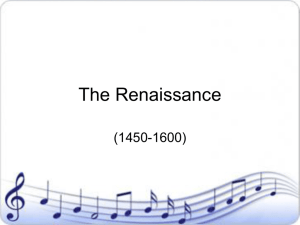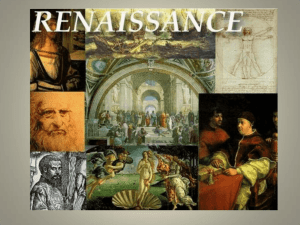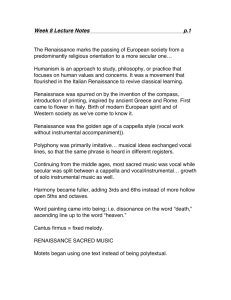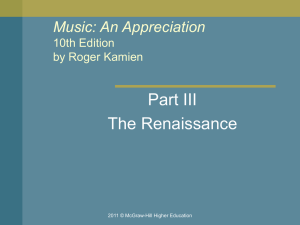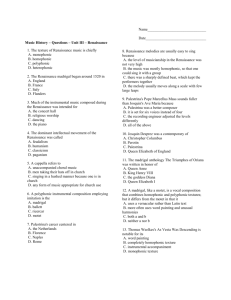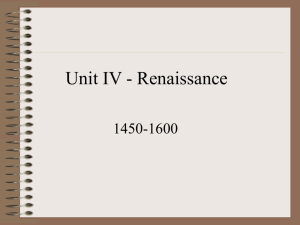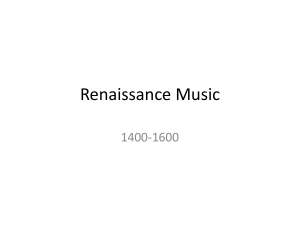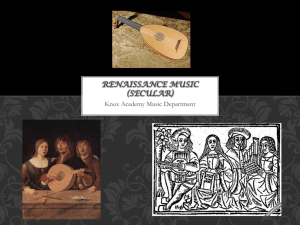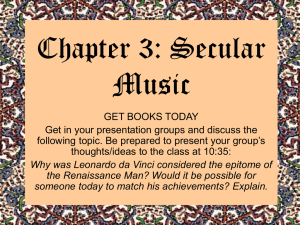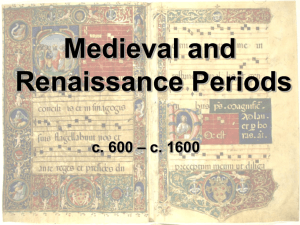Renaissance - midworld productions
advertisement
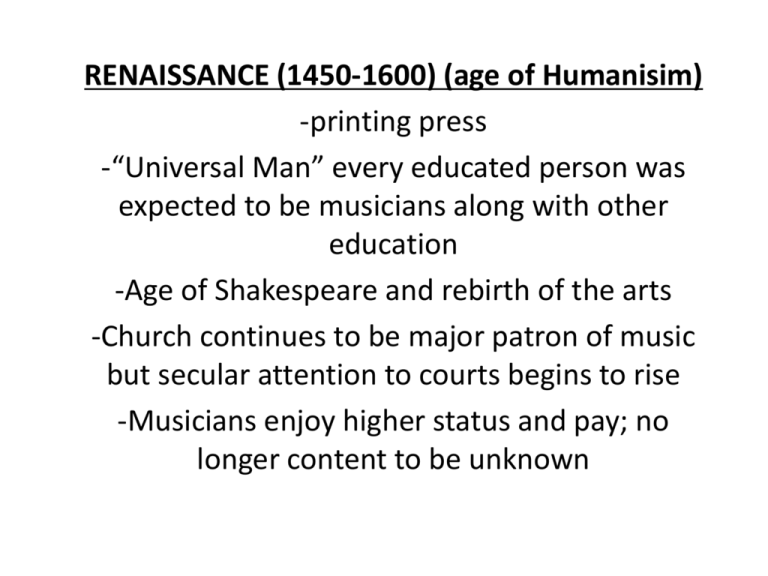
RENAISSANCE (1450-1600) (age of Humanisim) -printing press -“Universal Man” every educated person was expected to be musicians along with other education -Age of Shakespeare and rebirth of the arts -Church continues to be major patron of music but secular attention to courts begins to rise -Musicians enjoy higher status and pay; no longer content to be unknown RENAISSANCE (1450-1600) (age of Humanisim) Flemish Composers (Netherlands, Belgium, N France) highly regarded & held high positions across Europe Italy became leading music center in 16th cen. CHARACTERISTICS of RENAISSANCE MUSIC Words & Music vocal music more popular/important = humanistic interest in language influence WORD PAINTING with music begins still relatively balance though with no extreme contrast in dynamics, tone color, rhythm, ect… CHARACTERISTICS of RENAISSANCE MUSIC Texture mostly polyphonic with 4-6 voices in choral pieces with equal melodic interest imitation common among voices (as in a round) 1st Homophonic texture used in mostly light pieces like dances bass register used for the first time making fuller sound sound is more stable because of consonant chords w/ basslines GOLDEN AGE of a cappella choral music although occasional instruments are used but rarely notated for CHARACTERISTICS of RENAISSANCE MUSIC Rhythm & Melody gently flow rather than defined beat each melodic line has its own rhythmic independence = making both fun and challenging to sing melodies are usually easy to sing pitch wise making it easy to concentrate on rhythm SACRED MUSIC (Church Music) TWO MAIN FORMS THE MASS & THE MOTET • The Motet • Polyphonic choral work • Set to a sacred Latin Text other than the text of the Mass • Combines polyphonic and homophonic textures • Josquin Desprez(1440-1521) • Contemp of Leonardo da Vinci & Christhoper Columbus • Flemish composer • Born in Belgium • International career in Italy w/ dukes and the Papal Choir • Worked in France for Louis XII • Wrote masses, motets, and secular vocal • Martin Luther loved his music • • • • • • • LISTENING JOURNAL: • Josquin Desprez: AVE MARIA Four voice motet – prayer to virgin Mary polyphonic imitation adopted 1st part from chant but rest is original 2, 3, or 4 voices at one time mostly peaceful 2 beat 3 beat becomes more animated but returns to2 beat • Palestrina •& • The Renaissance MASS • The Renaissance Mass • Five Sections • 1. Kyrie • 2.Gloria • 3.Credo • 4.Santus • 5.Agnus Dei • Palestrina (1525-1594) • most important Italian Composer of time • devoted to Catholic Church music • career mainly in Rome • Prolific writer = 104 masses 450 other sacred works • Counter-reformation (Protestant break away) • New Council of Trent wanted to return to monophonic masses only and get rid of polyphonic “theater music” • Palestrina’s music is reflection of this but still maintained polyphony but with simpler and otherworldly style • Pope Marcellus Mass (1562) • Palestrina’s most famous mass • Thought to convince Council Of Trent that polyphony could remain in the church if done right • Dedicated to Pope Marcellus II • LISTENING JOURNAL: • Palestrina : Kyrie from Pope Marcellus Mass • Written for six a cappella voices • S/ A /(2) T / (2) B • Kyrie is 1st section of whole mass • Constant imitation • Flowing rhythm ‘til sustained chord at the end of each section • Has three sections ABA • Our recording is ABA’ faster tempo and louder but may not have been performed that way • RENAISSANCE (Secular Music) • secular vocal music became very popular as people branched out from the church setting • age of humanism • printing press help get copies to more people • RENAISSANCE (Secular Music) • Every educated person was expected to read and play music • Written for groups of solo voices • or for solo voice with 1 or more instruments to accompany • Imitation of natural sounds and many mood shifts unlike sacred music • MUCH MORE WORD PAINTING • The Renaissance Madrigal • piece for several solo voices set to a poem usually about love • combine polyphonic and homophonic textures but uses more word painting and unusual harmonies than Motets • madrigal originated in Italy around 1520 • The Renaissance Madrigal • 1588 the Spanish armada defeated by British consequently a volume of translated Italian madrigals published in London • In the age of Shakespeare and Queen Elizabeth I madrigals became popular using English • English madrigals were more light hearted than Italian • LISTENING JOURNAL : • WEELKES : As Vesta Was Descending • English composer of Madrigal’s • THOMAS WEELKES (1575-1623) • In “ENGLISH” • Listen for Word Painting • p.87 for text. • Instrumental Music • begins to take root. • mostly instruments were used to accompany vocal • instrumental mainly adapted versions of vocal music • gather what instruments you had and split up up vocal lines • no clearly defined notation • Most popular instrumental music was dance music • Pairs of dances (like line dancing) • The Stately • Pavane (Passamezzo) • duple meter • The Lively • Galliard in triple meter • PASSAMEZZO & GALLIARD by Caroubel • …not on your CD use youtube as ref • written by French violinist Caroubel • ..from dance collection put together by German Praetorius (1612) • Passamezzo for 6 unspecified parts • Galliard for 5 unspecified parts • ( our recording has modern instruments)
